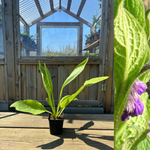Subscribe and save 10%!

True Comfrey Plant 20-40 cm (Symphytum officinale)
Expected delivery date: 20 December to 27 December.
Applies to orders within Sweden. For other countries - see our delivery terms .
In stock - Ready to be shipped
Share
1 plant True Comfrey
Common name: Comfrey
Scientific name: Symphytum officinale
Family: Boraginaceae
Plant history & use:
Comfrey is historically a well-used plant in the treatment of various ailments. But above all, it is a very effective accumulator of nutrients, i.e. a good soil improver. Comfrey grows quickly and its roots are deep, which gives the plant access to nutrients from deeper soil layers that are otherwise inaccessible to most plants. It is mainly minerals such as potassium and calcium that are stored in the leaves, but also magnesium, iron, phosphorus, manganese, etc.
The leaves of comfrey can be cut down throughout the year and used as mulch, or mixed into the soil to make the nutrients available to other plants. Comfrey leaves are good as fertilizer for fruit trees and berry bushes thanks to their potassium and phosphorus content.
Comfrey has a long growing season, from early winter to late autumn.
If the leaves are not cut down before winter, they will wither and provide nutrients to the soil they grow in. New leaves will start to grow on the plant immediately after the snow melts.
You can also make your own comfrey fertilizer by filling a container with the leaves and then filling it to the brim with water. Let it sit for a couple of days and then mix the fertilizer water with 10 parts water to water the plants.
Effective as an edging plant around manure piles to prevent nutrient leakage, but also as an edging plant around crops and other places where you don't want rotograss to spread. Comfrey's dense root system acts like an underground wall, making it difficult for other roots to get through.
Comfrey creates an attractive environment for other plants in the garden - whether it's to attract pollinators or to act as a natural fertilizer.
Culture:
Comfrey is a herbaceous perennial, meaning it continues to grow in the area even after the leaves have withered during the winter.
It is an extremely easy-care plant and is tolerant of site selection. It can grow in shade and wet soils, making it an effective component in flooded and waterlogged soils.
It also thrives well in drier soils in sunny locations, although it does best in a slightly moist environment.
Features:
Year: Perennial
Growing conditions: shade/partial shade/sun
Height: 50-100 cm
Growing zone: 1-6
- Choosing a selection results in a full page refresh.
- Opens in a new window.




